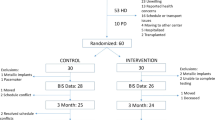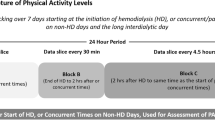Abstract
Objectives
The phenotype associated to reduced physical activity (PA) in dialysis patients is poorly documented. We here evaluate weekly PA in two independent cohorts.
Methods
Cross-sectional study with PA assessed by the number of steps/day measured by pedometer in two cohorts of prevalent dialysis patients: (1) peritoneal dialysis (PD) patients (n = 64; 62 ± 14 years; 70 % men) from Stockholm, Sweden using the pedometer for 7 consecutive days; (2) hemodialysis (HD) patients (n = 78; 63 ± 12 years; 65 % men) from a single center in Madrid, Spain using the pedometer for 6 consecutive days: 2 HD days, 2 non-HD midweek days and 2 non-HD weekend days. In both cohorts, comorbidities, body composition, nutritional status, and related biomarkers were assessed. Cohorts were not merged; instead data were analyzed separately serving as reciprocal replication analyses.
Results
Most patients (63 % of PD and 71 % of HD) were considered sedentary (<5,000 steps/day). PD patients had on average 4,839 ± 3,313 steps/day. HD patients had 3,767 ± 3,370 steps/day on HD-free days, but fewer steps/day on HD days (2,274 ± 2,048 steps/day; p < 0.0001). In both cohorts, and across increasing PA tertiles, patients were younger and had less comorbidities. Higher PA was also accompanied by better nutritional status (depicted by albumin, pre-albumin, creatinine and normalized protein catabolic rate in HD, and by albumin and subjective global assessment [SGA] in PD), higher lean body mass, and lower fat body mass (bioimpedance and/or dual-energy X-ray absorptiometry [DEXA]). Higher levels of PA were accompanied by lower levels of C-reactive protein in PD. Age and lean body mass were the strongest multivariate predictors of PA in both cohorts.
Conclusion
There is a high prevalence of sedentary behavior in dialysis patients. Better physical activity was consistently associated with younger age, lower presence of comorbidities and better nutritional status. Pedometers represent a simple and inexpensive tool to objectively evaluate physical activity in this patient population.


Similar content being viewed by others
References
Menotti A, Puddu PE, Lanti M, Maiani G, Catasta G, Fidanza AA (2014) Lifestyle habits and mortality from all and specific causes of death: 40-year follow-up in the Italian Rural Areas of the Seven Countries Study. J Nutr Health Aging 18(3):314–321
Wen CP, Wai JPM, Tsai MK, Yang YC, Cheng TYD, Lee M-C et al (2011) Minimum amount of physical activity for reduced mortality and extended life expectancy: a prospective cohort study. Lancet 378(9798):1244–1253
Brown RE, Riddell MC, Macpherson AK, Canning KL, Kuk JL (2013) The joint association of physical activity, blood-pressure control, and pharmacologic treatment of hypertension for all-cause mortality risk. Am J Hypertens 26(8):1005–1010
Edwards NM, Daniels SR, Claytor RP, Khoury PR, Dolan LM, Kimball TR et al (2012) Physical activity is independently associated with multiple measures of arterial stiffness in adolescents and young adults. Metabolism 61(6):869–872
Carrero JJ, de Jager DJ, Verduijn M, Ravani P, Meester JD, Heaf JG et al (2011) Cardiovascular and noncardiovascular mortality among men and women starting dialysis. Clin J Am Soc Nephrol 6(7):1722–1730
Davies CA, Vandelanotte C, Duncan MJ, van Uffelen JGZ (2012) Associations of physical activity and screen-time on health related quality of life in adults. Prev Med 55(1):46–49
O’Hare AM, Tawney K, Bacchetti P, Johansen KL (2003) Decreased survival among sedentary patients undergoing dialysis: results from the dialysis morbidity and mortality study wave 2. Am J Kidney Dis 41(2):447–454
Johansen KL, Sakkas GK, Doyle J, Shubert T, Adams Dudley R (2003) Exercise counseling practices among nephrologists caring for patients on dialysis. Am J Kidney Dis 41(1):171–178
Tentori F, Elder SJ, Thumma J, Pisoni RL, Bommer J, Fissell RB et al (2010) Physical exercise among participants in the Dialysis Outcomes and Practice Patterns Study (DOPPS): correlates and associated outcomes. Nephrol Dial Transplant 25(9):3050–3062
Tudor-Locke C, Williams JE, Reis JP, Pluto D (2002) Utility of pedometers for assessing physical activity: convergent validity. Sports Med Auckl NZ 32(12):795–808
Depner TA, Daugirdas JT (1996) Equations for normalized protein catabolic rate based on two-point modeling of hemodialysis urea kinetics. J Am Soc Nephrol 7(5):780–785
Daugirdas JT (1989) The post: pre dialysis plasma urea nitrogen ratio to estimate Kt/V and NPCR: validation. Int J Artif Organs 12(7):420–427
Gama-Axelsson T, Lindholm B, Bárány P, Heimbürger O, Stenvinkel P, Qureshi AR (2013) Self-Rated appetite as a predictor of mortality in patients with stage 5 chronic kidney disease. J Ren Nutr 23(2):106–113
Kyle UG, Genton L, Karsegard L, Slosman DO, Pichard C (2001) Single prediction equation for bioelectrical impedance analysis in adults aged 20–94 years. Nutrition 17(3):248–253
Tudor-Locke C, Craig CL, Brown WJ, Clemes SA, De Cocker K, Giles-Corti B et al (2011) How many steps/day are enough? for adults. Int J Behav Nutr Phys Act 28(8):79
Tudor-Locke C, Craig CL, Thyfault JP, Spence JC (2012) A step-defined sedentary lifestyle index: <5000 steps/day. Appl Physiol Nutr Metab 38(2):100–114
Johansen KL, Chertow GM, Ng AV, Mulligan K, Carey S, Schoenfeld PY et al (2000) Physical activity levels in patients on hemodialysis and healthy sedentary controls. Kidney Int 57(6):2564–2570
Zamojska S, Szklarek M, Niewodniczy M, Nowicki M (2006) Correlates of habitual physical activity in chronic haemodialysis patients. Nephrol Dial Transplant 21(5):1323–1327
Avesani CM, Trolonge S, Deléaval P, Baria F, Mafra D, Faxén-Irving G et al (2012) Physical activity and energy expenditure in haemodialysis patients: an international survey. Nephrol Dial Transplant 27(6):2430–2434
Nowicki M, Murlikiewicz K, Jagodzińska M (2010) Pedometers as a means to increase spontaneous physical activity in chronic hemodialysis patients. J Nephrol 23(3):297–305
Clyne N, Jogestrand T, Lins LE, Pehrsson SK (1994) Progressive decline in renal function induces a gradual decrease in total hemoglobin and exercise capacity. Nephron 67(3):322–326
Johansen KL, Kaysen GA, Dalrymple LS, Grimes BA, Glidden DV, Anand S et al (2013) Association of physical activity with survival among ambulatory patients on dialysis: the Comprehensive Dialysis Study. Clin J Am Soc Nephrol CJASN 8(2):248–253
Painter P, Moore GE (1994) The impact of recombinant human erythropoietin on exercise capacity in hemodialysis patients. Adv Ren Replace Ther 1(1):55–65
Carrero JJ, Bárány P, Yilmaz MI, Qureshi AR, Sonmez A, Heimbürger O et al (2012) Testosterone deficiency is a cause of anaemia and reduced responsiveness to erythropoiesis-stimulating agents in men with chronic kidney disease. Nephrol Dial Transplant 27(2):709–715
Mafra D, Deleaval P, Teta D, Cleaud C, Arkouche W, Jolivot A et al (2011) Influence of Inflammation on Total Energy Expenditure in Hemodialysis Patients. J Ren Nutr 21(5):387–393
Viana JL, Kosmadakis GC, Watson EL, Bevington A, Feehally J, Bishop NC et al (2014) Evidence for anti-inflammatory effects of exercise in CKD. J Am Soc Nephrol 25(9):2121–2130
Carrero JJ, Stenvinkel P, Cuppari L, Ikizler TA, Kalantar-Zadeh K, Kaysen G et al (2013) Etiology of the protein-energy wasting syndrome in chronic kidney disease: a consensus statement from the International Society of Renal Nutrition and Metabolism (ISRNM). J Ren Nutr 23(2):77–90
Carrero JJ, Chmielewski M, Axelsson J, Snaedal S, Heimbürger O, Bárány P et al (2008) Muscle atrophy, inflammation and clinical outcome in incident and prevalent dialysis patients. Clin Nutr 27(4):557–564
Gracia-Iguacel C, González-Parra E, Pérez-Gómez MV, Mahíllo I, Egido J, Ortiz A et al (2013) Prevalence of protein-energy wasting syndrome and its association with mortality in haemodialysis patients in a centre in Spain. Nefrologia 33(4):495–505
Ikizler TA (2011) Exercise as an anabolic intervention in patients with end-stage renal disease. J Ren Nutr 21(1):52–56
Acknowledgments
We thank the patients who participated in this study. From the Swedish side, we are indebted to Åsa Lindé for data and sample collection, and to our research staff Annika Nilsson, Anki Emmoth, Ulrika Jensen, Monica Ericsson and Ann-Christin Bragfors-Helin. From the Spanish side, we want to thank the collaboration of the whole staff at the hemodialysis unit. Gabriela Cobo benefits from a PhD scholarship from the Ecuadorian government, and the stay at Karolinska Institutet was supported by the Spanish Society of Nephrology. Patient data collection in Sweden was supported by an unrestricted grant from Amgen. This study also received support from The Swedish Medical Research Council and The Osterman and The Westman Foundations. Baxter Novum is the result of a grant from Baxter Healthcare Corporation to Karolinska Institutet.
Conflicts of interest
Gabriela Cobo: none; Paloma Gallar: none; Thiane Gama-Axelsson: none; Cristina Di Gioia: none; Abdul Rashid Qureshi: none; Rosa Camacho: none; Ana Vigil: none; Olof Heimbürger: none; Olimpia Ortega: none; Isabel Rodriguez: none; Juan Carlos Herrero: none; Peter Barany: none; Bengt Lindholm: employed by Baxter Healthcare Corporation; Peter Stenvinkel: none; Juan Jesús Carrero: none.
Author information
Authors and Affiliations
Corresponding author
Rights and permissions
About this article
Cite this article
Cobo, G., Gallar, P., Gama-Axelsson, T. et al. Clinical determinants of reduced physical activity in hemodialysis and peritoneal dialysis patients. J Nephrol 28, 503–510 (2015). https://doi.org/10.1007/s40620-014-0164-y
Received:
Accepted:
Published:
Issue Date:
DOI: https://doi.org/10.1007/s40620-014-0164-y




